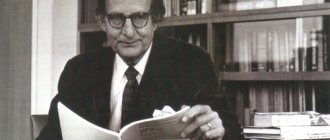Quite often, “accidents” (which, as we know, are not accidental) play an important role in a person’s life. For example, having chosen the road to escape from fate, we meet it there. And the one who finds the answer to the question of why this happens remains in people’s memory for a long time.
Largely due to finding non-standard answers to extravagant questions, the scientist Eysenck Hans Jurgen was remembered.
Eysenck's childhood and adolescence
All the most interesting things that can later play a key role in a person’s development happen in childhood. Hans Jürgen Eysenck (03/04/1916 – 09/04/1997) was the child of the “cultural intelligentsia” - both his mother and father were actors. Ruth Werner (under the pseudonym Helga Molander) shone on silent film screens, and Anton Edward Eysenck combined singing and acting. The parents had no time left for the child. And two years later they separated, and Hans Jurgen Eysenck was sent to be raised by his maternal grandmother.
From the memoirs of Hans Eysenck one can learn that the little grandson was always given complete freedom of action, and his pranks were treated leniently. Perhaps that is why the boy “tried everything for strength and authenticity.”
Hans Jurgen Eysenck was known in all circles for his “rebellious” style of behavior. Although it was precisely thanks to this feature that scientific ideas were put forward and their validity was proven.
Dream interpretation
This chapter literally repeats the title of Freud's work. “According to the theory of Freud and many others...dreams do not reveal anything about the future” [1, P. 438]. And they are dedicated exclusively to the past and present, in symbolic form. Here, too, one cannot do without a critical approach to psychoanalysis: Freud believed that in a dream everything has meaning (but this idea existed in culture for a long time, and he only popularized it), everything is connected with the satisfaction of desire (and this is also not original), and consciously suppressed (and only this thought is truly Freud’s discovery (see: [1, p. 439]). And the method of verbal associations, as Eysenck proves, is rather a discovery of F. Galton. In addition, the legitimacy of the symbolic interpretation of dreams has not been proven ( Thus, Hall argued that the same action causes different reactions and associations in different people).
Moving to England
Hans became aware of his uniqueness while still at school: he often liked to demonstrate the superiority of his knowledge of a subject over the knowledge of teachers who graduated from military universities. Being the first athlete at school, he openly expressed his negative impressions of the Nazi rally and Hitler speaking at it. His comrades, in agreement, beat him with a crowd. However, this did not bother the future Doctor of Philosophy. The next day, Hans caught his offenders one by one and inflicted “justice.” True, the ability to take a punch did not help the young man when entering the University of Berlin.
For the first time in his life, the young man was faced with a choice: joining the Nazi secret police and entering the university or having his candidacy rejected as a student. Hans Jurgen Eysenck leaves Germany and goes to England.
Studies
He received his education in European private schools. Often loving to demonstrate his superior knowledge over teachers who graduated from military universities, he was also superior to many physically. So, after he expressed his disapproval of fascism and Hitler in particular, the school staff beat him up with almost the entire staff. However, his answer to the offenders was also not long in coming. The teachers had difficulty hushing up the scandal, which threatened to turn into a massacre.
After graduating from high school, he was accepted into the Faculty of Philosophy at the University of Berlin. However, there they persistently hinted at the need to join the SS, so his mother and stepfather (a Jewish director) decided that it would be better to leave the country. At the University of Dijon, in France, he studied history and literature, and the next year he entered the University of London, in England. There Eysenck asked to study at the Faculty of Physics, but after a course in history and philosophy he could only be accepted into psychology. He agreed to agree, but caused quite a scandal in the process.
Thanks more to his ability to talk on any topic and self-confidence than to actual knowledge, he graduated from the university with honors and received a red diploma. Professors dubbed him “the hope of future science” and gave him good recommendations, and several private colleges even invited him to give lectures.
Professional development
The move adjusted Hans's plans. Dreams of entering the physics department of the University of London did not come true for a number of reasons. However, not wanting to lose a whole year due to non-compliance with the requirements, Eysenck enrolls in a psychology course. In 1938, the young psychologist received a bachelor's degree. And in 1940 he became a Doctor of Philosophy.
From the same year, Hans began working at Mill Hill Hospital, accepting patients with various psychiatric problems. It should be noted that up to this point Eysenck had not had any psychiatric or clinical practice. This did not mean that the young Ph.D. would succumb to difficulties. Hans considers the criteria and categories of clinical diagnosis unsatisfactory and finds it possible to apply only the factor theories of personality that were being developed at that time in practice. Thanks to this research, extensive practice and tireless observations, the theory of personality formation was formalized in the book “Dimensions of Personality” (1947).
Factor analysis is the contribution of Eysenck Hans Jurgen to psychology and partly psychiatry of that time. He noticed that two main factors stand out when describing personal qualities: neuroticism on the one hand and extraversion (introversion) on the other. This idea will receive its final form in 1970.
In the post-war years, Eysenck continued to work in the psychiatric department as director and after some time became a teacher at the University of London.
In order to study the psychiatric practice of Western colleagues, in 1949 he went to work as a visiting professor in Pennsylvania. Not surprisingly, clinical psychology training programs in the United States and Canada were characterized by Hans as “unscientific.”
In 1950, Eysenck returned to Europe.
Hans Eysenck
- home
- Famous personalities
- Famous psychologists
- Hans Eysenck
Hans Jurgen Eysenck was born on March 4, 1916 in Berlin. His mother, Ruth Werner, was a talented actress and later became a silent film star. Father, Anton Edward Eysenck, was also an actor and singer. Subsequently, the scientist recalled that “I felt very little attention from my parents, who divorced when I was 4 years old, and did not have particularly warm feelings for me, but I paid them back in kind” (1990a, p. 40). His parents divorced when Hans was two years old, and the boy remained to live with his maternal grandmother. She also once worked in the theater, but her promising opera career was cut short due to the tragic loss of her voice. Eysenck wrote that his grandmother was “selfless, caring, unselfish and generally too good for this world” (p. 40). Although his grandmother was a devout Catholic, Eysenck's parents were not religious, and Hans himself grew up without any formal religious guidance.
Remembering his childhood, Eysenck always emphasized the freedom he enjoyed. None of his parents controlled his actions; his grandmother was also very lenient. Two examples serve as good illustrations of such free education. In the first case, the father bought Hans a bicycle and promised to teach him to ride. “He took me to the top of the hill, told me I had to sit on the saddle and press the pedals, and then went about his business... leaving me to learn on my own” (Eysenck, 1990c, p. 12). The second memorable incident occurred when the teenager Hans told his grandmother that he was going to buy cigarettes, expecting her to tell him not to do so. However, the grandmother replied: “If you like it, do as you want” (p. 14).
Growing up in an atmosphere of semi-bohemian freedom, young Hans did not tolerate totalitarianism in any of its manifestations. He often bullied his teachers, especially those who were educated in military schools. Eysenck was very skeptical about the knowledge that they could give him, and did not always refuse the opportunity to confuse them with his superior knowledge. In his memoirs, he described himself as “a prude and a pedant... who did not tolerate fools (or even ordinary people)” (Eysenck, 1990, p. 31).
The difficult times that followed the First World War: hardships, astronomical inflation, mass unemployment and the threat of famine seemed to be a thing of the past with Hitler's rise to power. The country began to experience economic growth, and scientists and specialists were needed. However, when the talented young man, having graduated from school, intended to enter the University of Berlin to study physics, he was confronted with a fact: an indispensable condition for his acceptance was joining the Nazi secret police. This idea seemed so disgusting to him that Eysenck decided to leave Germany, later writing about this: “I knew that there was no future for me in my unhappy homeland” (Eysenck, 1982, p. 289).
The encounter with fascism and subsequent battles with the radical left led Eysenck to believe that the trait of rigidity or authoritarianism was equally characteristic of both ends of the political spectrum. He subsequently found scientific support for this hypothesis, finding in one of his studies that although communists are radicals and fascists are conservatives, in terms of one of the personality characteristics, namely hard thinking/tolerance, these groups are similar to each other. Both of them showed greater levels of authoritarianism, rigidity, and intolerance of other people's opinions than the control group (Eysenck, 1954).
At the age of 18, Eysenck left Germany and settled in England, where he decided to enter the University of London to study psychology, where he received a bachelor's degree in 1938. A truly anecdotal story is connected with his admission. Eysenck's initial choice of specialty was made in Berlin - in favor of physics. However, a random event changed the course of his life, and subsequently the entire history of psychology. To enter the university, one had to pass an entrance exam, for which Eysenck prepared for a year while studying at a commercial college. Having passed the exam in 1935, he was sure that he had entered the university to study physics. However, it turned out that he had taken the wrong exam by mistake and was not eligible to take the physics course. Instead of waiting another year, he inquired whether there was any other course to which he could be admitted. When Eysenck was told that he could study psychology, he allegedly asked: “What is this psychology?” (Eysenck, 1982, p. 290).
Having received his PhD in 1940 and by this time already married for two years to Margaret Davis, a Canadian who graduated from the Faculty of Mathematics at the University of London, Eysenck found himself in the position of a “hostile foreigner” in England. He was not interned, but he was not able to take part in the war against fascism, which he hated. Instead, without any psychiatric or clinical training, he began working at Mill Hill Emergency Hospital, treating patients suffering from a variety of psychiatric symptoms, including anxiety, depression and hysteria. However, the traditional categories of clinical diagnosis did not satisfy Eysenck. Using factor analysis, he found that all traditional diagnostic groups could be described by two basic personality factors: neuroticism and extraversion/introversion. These theoretical studies led to the publication of his first book, Dimensions of Personality (Eysenck, 1947). After the war, Eysenck became director of the psychiatric department of Maudsley Hospital and, somewhat later, a lecturer at the University of London.
Considering the level of English clinical psychology to be insufficiently high, in 1949 Eysenck traveled to North America to become acquainted with psychological programs in the United States and Canada. From 1949 to 1950, he served as a visiting professor at Pennsylvania State University, but much of his time during this period was spent traveling throughout the United States and Canada and studying existing clinical psychology programs, which he found completely unscientific (Eysenck, 1980, 1990 p. ).
Returning to England, Eysenck divorced his first wife and on October 30, 1950, married Sybil Rostal, a psychologist and daughter of a famous violinist, whom he met during a trip to Philadelphia. Hans and Sybil Eysenck published several books together and had three sons and a daughter. Eysenck's son from his first marriage, Michael, is currently a widely published author of articles and books on psychology.
At the University of London, Eysenck founded the department of clinical psychology, and from 1955 to the mid-80s he was a professor at the Institute of Psychiatry. In addition, until his retirement in 1983, he served as chief psychiatrist at the Royal Maudsley Hospital and the famous Bedlam Mental Hospital. He then continued to work at the University of London as a retired professor (professor emeritus) until his death from cancer on 4 September 1997. In the last years of his life, Eysenck continued to be involved in various issues in personality psychology, including creativity and creativity (Eysenck, 1993, 1995), as well as the influence of behavior on the development of cancer and heart disease (Eysenck & Grossarth-Maticek, 1991).
While still in the United States, Eysenck began working on his most famous book, The Structure of Human Personality (1952b), in which he argued for the effectiveness of factor analysis as the best method for representing known facts about personality. In total, Eysenck surpassed even Cattell in the number of published works. In addition to almost 800 journal articles and individual chapters, he wrote more than 75 books, some of them with catchy, public-facing titles such as “Uses and Abuses of Psychology” (1953), “Meaning and Meaninglessness.” in Psychology” (Sense and Nonsense in Psychology, 1956), “Fact and Fiction in Psychology” (1965), “Psychology Is About People” (1972b), “You and neurosis (You and Neurosis, 1977b), Sex, Violence and the Media, co-authored with DKB Nias (Sex, Violence and the Media, 1978), Smoking, Personality Traits and stress" (Smoking, Personality and Stress, 1991 c) and "Genius: The Natural History of Creativity, 1995".
Famous psychologistsBiography Psychology
More interesting things in telegram @calcsbox
Becoming a scientist
What contribution did Eysenck Hans Jürgen make to science? Currently, few people think about the emergence of such familiar concepts and phenomena. However, some of them began to exist not so long ago. Eysenck watched with bated breath, as far as possible, the genetic experiments carried out at Ahnenerbe. The young scientist had the opportunity to conduct brain research himself with the intention of identifying a correlation between brain size and human intelligence. Such experiments have so far not led anyone to establish any patterns, but Hans needed to make sure of this.
Border zones of science: hypnosis and suggestibility
In the second part of his work, Eysenck examines the phenomenon of hypnosis. As in the case of psychoanalysis, many patients claim improvements after sessions, but it is not possible to verify these results (experiments of Mesmer, Braid, Bernheim, Libo, Charcot). The pattern is as follows: “the simpler the task, the greater the improvement, and vice versa, the more complex the task, the smaller the improvement will be” [1, P. 335]. If we turn to Freud, he himself believed that the degree of immersion in a hypnotic state is directly related to the degree of transference. The concept of “transference” is interpreted in Eysenck’s book in a broader sense than Freud himself understood.
Bird's influence on the formation of Eysenck's concepts
The young scientist’s scientific supervisor was Cyril Lodovik. He is known for his categoricalness in the matter of intellectual development. From his point of view, intellectual abilities are an innate property (like eye color). The proof was provided by studies based on Binet-Simon tests. Eyewitnesses claimed that Cyril was a good mathematician and was trying to calculate the exact distribution of innate and acquired intelligence factors.
Burt was responsible for the development of the theory of the two-factor structure of intelligence (the idea itself was expressed by Charles Spearman). Subsequently, Cyril’s persistent attribution of the authorship of this concept to himself allowed some critics to speak out about the scientist’s ill health (he was considered paranoid).
Much, if not all, of Burt's writings can be found in Eysenck's statements. We can say that Hans brought the system to perfection. Today it is known throughout the world as an IQ test.
Famous questionnaires of the psychologist
Studying in detail the influence of environment and heredity on intelligence, as well as the structure and types of personality, Eysenck created many tests in the form of questionnaires that help to conduct a complete diagnosis of a person’s mental state in order to get a general idea of his character, actions, psychological reactions and propensity for one or another. a different model of behavior.
Among others, the Eysenck self-esteem test is often used. For the most part, such questionnaires are used in educational institutions. Self-assessment of mental states according to Eysenck allows us to identify the level of self-esteem of students, as well as determine the level of four main mental states:
- Anxiety.
- Aggressiveness
- Frustration.
- Rigidity.
The test itself consists of 40 questions specific to each specific condition. The respondents are offered three answer options: “yes”, “no” and “sometimes”. After processing the test results, you can get a very plausible picture of the test subject’s condition and understand how adequate his self-esteem is.
In addition, Eysenck’s theory of different personality types, built on the concept of a hierarchical model of human personality (where the highest level is represented by superfactors, and the lower level by specific thoughts and actions of a person), allowed the scientist to create a personality questionnaire (a test for determining temperament). It is a list of questions that relate to the behavioral characteristics of the person being directly assessed.
This technique of G. Eysenck was developed by the scientist based on the results of his tests, in which more than 30,000 people participated. Initially, the subjects simply answered questions (there were 2 options of 57 questions each), but later Hans Eysenck, together with Sibylle Eysenck, developed a new assessment method, in which, in addition to questions that were used to diagnose a person’s behavioral characteristics and a “lie” scale, there were and additional ones - on the definition of psychotism. In total, a person had to give 101 answers.
We recommend: What is character?
Both the original and the later proposed methods include questions that are absolutely relevant to the three main factors of personality structure, and the “lie” scale in both the first and second cases helps to identify the respondent’s tendency to falsify answers.
By the way, the initial test, which allows you to determine the type of temperament, is more popular than the questionnaire compiled later. And this is explained by the number of questions, of which in the first case there are only 57.
Ph.D. Family
The personal life of Hans Jurgen Eysenck was not as controversial as his social and scientific life. In 1938, the psychologist married Margaret Davis, who was also a student at the University of London, but in the department of mathematics. A native of Canada was married to Eysenck until 1950. The son Michael, born in this marriage, subsequently became a famous author of books on psychology, and the book “A Study of the Human Psyche” became a joint work of son and father.
Immediately after his divorce from Margaret, Hans marries Sybil Rostal (whom he met while traveling in Philadelphia). Daughter of violinist Max Rostal, psychologist, mother of four children (the couple had 3 boys and a girl)
Together with her husband, she published several books (mostly modified tests). Eysenck's wife and children, Hans Jurgen, supported him in everything and were his only outlet, while the entire scientific world was raging. The famous psychologist never considered family relationships from the point of view of Freud's psychoanalysis. In addition, he spoke unequivocally about the Oedipus complex. In Hans Jürgen’s short biography of Eysenck, family relationships are almost always ignored, but fruitful joint work with members of the household speaks of the mutual understanding and support that reigned in the scientist’s family.
Intellectual differences
Eysenck's public reputation has recently been overshadowed by his popular writings on intelligence - although he came to it late as a research topic - because these reflections touched on some sensitive areas of public interest. In the late 1960s, as his four children from his second marriage were starting secondary education, the British government envisioned major reforms aimed at straightening out the tripartite structure of the secondary school system. Eysenck quickly identified himself as an enemy of these reforms and further argued that compensatory measures, such as more money for facilities and teacher salaries in poorer regions of the country, would be ineffective or even counterproductive for those targeted. He raised his profile even further with his 1971 book supporting Arthur Jensen's claim that black-white differences in IQ scores were partly heritable. While Race, Intelligence and Education was poorly received by many of his peers, the groups' vehement protests showed that Eysenck had emerged as a symbol of freedom of scientific expression.
However, the public harassment he suffered was enough to ensure that he largely avoided discussing the issue of race.
The Cyril Burt scandal in the mid-1970s, in which Burt was accused of producing data showing that intelligence was inherited, brought Eysenck back into the nature versus nurture debate. In the end, he reluctantly distanced himself from the dubious practices of his old mentor, but not from his general ideas. Eysenck might have reiterated his claim that intellectual differences were 80 percent heritable—a high-level estimate in the field—most notably defending this position in a 1981 confrontation with Leon Kamin, co-author of The Intelligence Debate. In the latter part of his post-retirement career, Eysenck also played a key role in efforts to increase intelligence using vitamins. In some ways, he even suggested that nutritional factors may be responsible for racial differences.
Eysenck's research on intelligence began only in the late 1970s, when Eysenck also played a leading role in defining concepts and leading debates. Throughout his career he remained committed to the concept of general intelligence, or g , created by his intellectual ancestor Charles Spearman . True to his London School view, Eysenck focused on individual differences rather than components of intelligence. He attempted to avoid the circularity of psychometric definitions of intelligence by looking beyond IQ tests to explore the relationship between intellectual differences and central nervous system functioning.
In the early 1980s, Eysenck encouraged psychologists to take another look at Francis Galton's (1822–1911) contention that processing speed was an important factor in intellectual differences. Eysenck advised that reaction time and electroencephalogram (EEG) measures of brain activity showed great promise. However, Eysenck's own EEG research in the early 1990s was extremely disappointing, and the biological basis of intelligence remained a work in progress. Speed was an important but not decisive factor, and Eysenck suggested that it was a by-product of more efficient, error-free neural transmission.
Scientist's legacy
Eysenck's extraordinary personality manifested itself in everything from defending his scientific beliefs to provocative behavior (for which he was nicknamed the "terrible child of the seventies"). The scientist's legacy includes 45 books and more than 600 articles.
He founded and edited such journals as Behavior Research and Therapy and Personality and Individual Differences. The basis of Eysenck's concept was such personality factors as extraversion - introversion and neuroticism - stability. After some time, a third type of personality dimension appeared in theory (psychotism - the strength of the superego), with the assumption that this is a genetic predisposition to personality development along a psychotic or psychopathic line.
Based on the models of behavioral reactions developed by the psychologist, a method of personality correction was proposed - aversive psychotherapy (or aversion therapy). Many centers for helping people with drug addiction use this type of therapy as their main one.
Personality, smoking and illness
Eysenck's other important initiative after his retirement was to study the relationship between temperament and physical health. In the early 1960s, a collaboration with oncologist David Kissen suggested a link between cancer and personality. Eysenck soon attracted more attention by stating that the causative role of cigarettes in cancer had not been convincingly proven. Eysenck received a boost of criticism from public health advocates as the anti-smoking message became more visible and compelling in the late 1960s.
Eysenck revisited the issue in the early 1980s and presented new genetic evidence linking personality, smoking and disease. In a series of papers in the late 1980s and early 1990s, Eysenck and the little-known Yugoslav researcher Ronald Grossart-Maticek reported a series of longitudinal studies apparently demonstrating a striking link between personality types and cancer and coronary heart disease. Although Eysenck did not organize these studies, his contributions helped fine-tune the presentation and analysis. There have been a number of interventions suggesting that psychotherapy can have surprisingly beneficial effects for cancer patients and people with unhealthy lifestyles. While the scope and ambition of these investigations was welcomed, critics complained of a lack of methodological control and descriptive detail. Some, such as Anthony Pelosi and Louis Appleby, even suggested that the results were "too good to be true."
Hobbies of Ph.D.
The biography of Hans Jurgen Eysenck tells the story of his passionate youthful interest in astrology. Naturally, he approached this issue with all the seriousness of a research scientist. The study of astrological charts was carried out with the same goal: to find a pattern that contributes to the development of talent. While studying the topic, Eysenck corresponded with many famous astrologers. He drew up and mailed cards to some representatives of the Reichstag warning them of the collapse of all their plans. But there was no answer.
Observations of fascism and the radical left led the scientist to the conclusion that these groups are more similar than different. Both had an authoritarian management style, rigidity and intolerance of dissent, in contrast to the control group. Perhaps this hypothesis only strengthened the scientist’s belief in the importance of the biological component in the nature of intelligence.
Social attitudes
This is also an important issue that affects the development of society in the broadest sense. Stereotypes are something we encounter every day. And their modality (positive or negative) is associated with established subjective relationships. So, speaking about anti-Semitism, Eysenck gives a test for attitudes towards Jews and along the way proves that the basis of any stereotype is emotion - which means that no evidence or appeals to the mind work. Likewise, public opinion polls are important and in demand, especially now, but the methodology and correctness of their preparation leave much to be desired: errors in the wording of answers and factors influencing the answers are revealed. That is, the question of the validity of the survey is very important (it is interesting that Eysenck himself was criticized for the vagueness, or even incorrectness, of the answers and wording in his intelligence tests).
Factor theory of personality
Eysenck Hans Jurgen's significant contribution to psychology is considered to be the model of the three-phase concept of the emergence of neurosis, which describes neurosis as a manifestation of learned behavioral reactions. Like Raymond Kettle, he uses factor analysis to show how personality traits influence behavioral responses. Unlike Cattell, Eysenck was convinced that to explain human behavior, three supertraits are sufficient (his opponent has 16), which are called types (introversion - extraversion, stability - neuroticism and psychoticism - superego strength). This structure of types was formed on the basis of Eysenck's belief that they are inherited at the biological level (although the influence of the external environment is not excluded).
The basis for constructing his theory was the work of his colleagues E. Kretschmer and K. Jung. Eysenck considered their typologies as one whole.
The novelty of personality theory is the consideration of psychological manifestations as continuums of meanings, and not as extreme manifestations of types.
Scientific activity
A number of Eysenck's studies were perceived as "shocking"; their themes, quite normal for Nazi Germany, seemed unacceptable in Europe. In particular, he examined psychological differences between representatives of different races. American wholesale and retail booksellers refused to distribute Eysenck's The IQ Argument (1971) due to threats of violence and arson, making it impossible to purchase the book in the United States in the early 1970s. American newspapers in those years refused to publish reviews of it.
Eysenck began his studies of basic personality traits with an analysis of the results of a psychiatric examination of a contingent of soldiers - groups of healthy people and those recognized as neurotic. As a result of this analysis, 39 variables were identified in which these groups turned out to be significantly different and factor analysis of which allowed us to obtain three factors, including the factors of extraversion-introversion and neuroticism (“Dimensions of Personality”, 1947). As a methodological basis, Eysenck focused on understanding the psychodynamic properties of personality as determined genetically and ultimately determined by biochemical processes (“The Scientific Study of Personality”, 1952). Initially, he interpreted extraversion-introversion based on the relationship between the processes of excitation and inhibition:
- extroverts are characterized by the slow formation of excitation, its weakness, and the rapid formation of reactive inhibition, its strength and stability;
- for introverts, the rapid formation of excitation, its strength (this is associated with their better formation of conditioned reflexes and their rapid learning), and the slow formation of reactive inhibition, its weakness and low stability.
As for neuroticism, Eysenck believed that neurotic symptoms are conditioned reflexes, and behavior that represents the avoidance of a conditioned reflex stimulus (danger signal), and thereby eliminating anxiety, is valuable in itself.
It should be noted that Eysenck rethought the terms extrovert and introvert, introduced by C. G. Jung - initially they had a different content.
In his work “The Biological Basis of Personality”, 1967, Eysenck proposed the following interpretation of these two personality factors:
- a high degree of introversion corresponds to a decrease in the activation threshold of the reticular formation, therefore introverts experience higher arousal in response to exteroceptive stimuli;
- and a high degree of neuroticism corresponds to a decrease in the activation threshold of the limbic system, therefore, individuals with high scores on this scale have increased emotional reactivity in response to events in the internal environment of the body, in particular to fluctuations in needs.
As a result of further research using factor analysis, Eysenck formulated the “three-factor theory of personality.”
Three Factor Theory of Personality
The three-factor theory of personality is based on the definition of personality traits as a way of behavior in certain areas of life:
- at the lowest level of analysis, isolated acts in specific situations are considered (for example, the currently manifested manner of entering into a conversation with a stranger);
- at the second level - frequently repeated, habitual behavior in essentially similar life situations; these are ordinary reactions diagnosed as superficial traits;
- at the third level of analysis, it is discovered that repeated forms of behavior can be combined into some meaningfully uniquely defined complexes, first-order factors (the habit of being in company, the tendency to actively engage in conversation, etc. give grounds to postulate the presence of such a trait as sociability);
- finally, at the fourth level of analysis, meaningfully defined complexes themselves are combined into second-order factors, or types that do not have an obvious behavioral expression (sociability correlates with physical activity, responsiveness, plasticity, etc.), but are based on biological characteristics.
At the level of second-order factors, Eysenck identified three personality dimensions: psychoticism (P), extraversion (E) and neuroticism (N), which he considered genetically determined by the activity of the central nervous system, which indicates their status as temperamental traits.
In the vast number of applied studies that Eysenck conducted to prove his theory (most often, together with specialists in the relevant fields), the importance of differences in these factors was shown in crime statistics, in mental illness, in susceptibility to accidents, in the choice of professions, in the severity of the level of achievements, in sports, in sexual behavior, etc. Thus, in particular, it was shown that according to the factors of extraversion and neuroticism, two types of neurotic disorders are well differentiated: hysterical neurosis, which is observed in persons of choleric temperament (unstable extroverts) , and obsessive-compulsive neurosis - in people of melancholic temperament (unstable introverts). He also conducted numerous factor-analytic studies of various psychological processes: memory, intelligence, social attitudes.
Based on the “three-factor model of personality,” Eysenck created the psychodiagnostic methods EPI (“Manual of the Eysenck Personality Inventory”, jointly with Sybil BG Eysenck, 1964) and EPQ [1] (inaccessible link), which continued a number of previously created ones (MMQ, MPI ( "Manual of the Maudsley Personality Inventory", 1959)).
Three-phase theory of the emergence of neurosis
Eysenck is one of the authors of the “three-phase theory of the emergence of neurosis,” a conceptual model that describes the development of neurosis as a system of learned behavioral reactions (“The Causes and Cures of Neuroses,” jointly with S. Rachmann, 1965). Based on this behavioral model, methods of psychotherapeutic personality correction were developed, in particular, one of the variations of aversive psychotherapy.
Author's books
In all of Eysenck's books, Hans Jurgen runs through the idea of the leading role of genetic and neurophysiological factors in the formation of various behavioral reactions. As a true psychologist, the scientist is famous for his “challenging” headlines. For example, “The benefits and harms of psychology”, “Meaning and meaninglessness in psychology”, “Facts and fiction in psychology”, “Sex, violence and the media”.
Perhaps Eysenck's most famous book is The Structure of Human Personality, which provides evidence of the effectiveness of factor analysis in the study of personality traits, talents and predispositions.
Basic concepts of Eysenck's theory
Eysenck the psychologist worked on the study of personality. In his view, it appears as a complex hierarchical structure.
The hierarchy of personality can be traced from a person’s simple reactions to repeated situations to the type of his temperament. An example of this would be communication between people. A person may respond without enthusiasm to other people’s suggestions to spend time actively. At the same time, he always maintains his distance and prefers solitude. This speaks of his unsociability. But in general, both of these parameters may indicate introversion.
Special works
Hans Jürgen did not ignore such a sensitive topic as criminal behavior. In 1964, the book “Crime and Personality” was published. There is not even a hint of the famous Lombroso theory in it. According to Eysenck, individuals with high levels of extraversion, neuroticism and psychism, due to the costs of socialization, can become criminals. The author put forward a hypothesis about the presence of a “criminal class” group in the population. It is worth noting that this work caused a lot of criticism and controversy in the scientific community, but it also acquired followers.
How to take the test
To pass the Eysenck personality test, you need to answer the questions below, and then use the key to decipher the answers. It is worth noting that the questions posed must be answered unambiguously (negatively or affirmatively). In addition, do not think about your answer, immediately indicate “yes” or “no”.
So, the key to the test will be the following answers that match the specified values:
In order to process the responses, you need to evaluate them. For answers that match the key, 1 point is given. Thus, having calculated the results, you can analyze the data:
- On the extraversion scale: a bright extrovert will receive more than 19 points, an extroverted personality will receive more than 15 points, the average value of extraversion will be 12 points, a deep introvert will have less than 5 points and less than 9 for a simple introvert.
- On the neuroticism scale: a score of 19 or more is considered very high for neuroticism. Those who scored more than 14 had a high level of neuroticism. The average value of neuroticism varies between 9-13 points. And a low level - when the respondent got less than 7 points.
- On the “lie” scale: the acceptable value for this scale is 4 points. If the test taker managed to score more than 4 points, then this indicates the individual’s tendency to consciously lie for the sake of universal approval.







